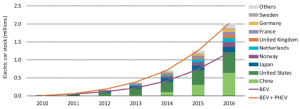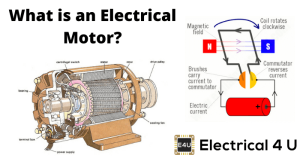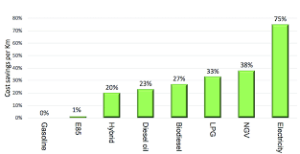Technology
136 Electric Motors
Peyton Pitts and Hunter Senn
introduction
Society and technology are codependent. For example, one can take something simple like a spoon and see how much that innovation has changed the way we, as a society, do mundane tasks. One of the most impactful inventions of the last two hundred years is the invention of the internal combustion engine. As discussed in previous chapters, the path dependence theory states that modern day decisions can be heavily influenced by the past, and that the circumstances that led to this decision may or may not still be relevant to today. This shows why society is so hesitant to change our ways away from the internal combustion engines, despite their contribution to the carbon footprint and inefficiencies, and toward electric motors. An electric motor can be defined as an electrical machine that converts electrical energy into mechanical energy. Some experts argue that the electric motor gives off less of a carbon footprint, is more efficient, and is more sustainable for society which is why we might should consider them as an alternative. The goal of this chapter is to shed some light onto electric motors by giving some insight into the history, state how electric motors work, and some potential benefits of electric motors.
Missing Voices
A missing voice is someone who hasn’t been credited for their discovery. This can be seen in the innovation of electric motors. Moritz Jacobi, though he was not the first inventor of the electric motor, he was the first one to be able to design one in such a way to be useful.
After many quasi-successful attempts with relatively weak rotating and reciprocating apparatus, the German-speaking Prussian Moritz Jacobi created the first real rotating electric motor in May 1834. (Doppelbauer, M.,2024). This produced a remarkable mechanical output power. This was the first look at a more sustainable option rather than the coal fed trains that dominated the industry at the time. His motor set a world record which was improved only four years later in September 1838 by Jacobi himself. His second motor was powerful enough to drive a boat with 14 people across a wide river. It was not until 1839-40 that other developers worldwide managed to build motors similar and then later of higher performance (Michalowicz, J. C., 1948).
Society With Electric Motors
In the 1830s people didn’t really find electric motors as useful compared to combustion engines, however with current climate issues, advancements in the realm of electric motors, and lithium battery design electric motors are becoming more and more practical.
Era Benefits:
- Combustion engines were more reliable and efficient during the earlier periods of electric motor development
- 26% of the combustion energy is converted to mechanical energy so the thermal efficiency isn’t very good
- A combustion engine is small explosions that get converted into power (causing vibrations) and an electric motor is a spinning magnet that gets converted into power
- Electric motors made modern America, they are used in everything we use every day to do normal tasks like dishwashers, vacuums, and printers
- While they are used in everyday life they are also used in larger scaled things like aircraft and cars
- People love “American Muscle” and love the roar of an internal combustion engine, however electric motors provide immediate torque and are capable of faster speeds: Gas powered car vs Electric motor car
Question
Do you think we should make a full transition into pure electric motors and if so how should society make the switch?

If you look at this chart you can see that the majority of the world is already making the switch into electric and hybrid vehicles while the United States is dragging behind (Sturgeon, Timothy & Chagas, Leonardo & Barnes, Justin, 2017).
Electric vehicles have appeared as a model of sustainability and respect to the environment, due to the fact they do not emit harmful substances to the air, unlike conventional internal combustion vehicles. Such sustainability is not only limited to the usage of hybrid or electric vehicles, but also their design, the prime materials used in the manufacturing of these vehicles, and the energy footprint during its use, as well as the subsequent recycling of their components influencing the circles of sustainability.
How does it work?

Electric motors operate using principles of electromagnetism, which shows that a force is applied when an electric current is present in a magnetic field. This force creates a torque on a loop of wire present in the magnetic field, which causes the motor to spin and perform useful work.

When looking at an electric motor’s efficiency you can see that it doesn’t lose any power until almost 90% RPM. While a gas motor would lose efficiency around 65-70% RPM (Hughes, A., & NetLibrary, I, 2006).
Resolution/Conflict?
In other countries the switch to electric motors can been seen already happening. The annual carbon footprints of Swedish passenger car travel as well as annual tailpipe CO2 emissions are estimated to decrease when introducing a ban on sales of new passenger cars with ICEs by 2030. Annual carbon footprints could be as low as 1.5 to 5.1 MtCO2 by 2060, depending on the decarbonization of background systems (i.e., vehicle and battery manufacturing, and fuel production). This can be compared to 5.8 to 9.1 MtCO2 (assuming increased shares of biofuels until 2030 in line with Swedish biofuel policy) if no ban is introduced. The effect of introducing a ban is delayed because of the lifetime of cars in the fleet of about 17 years (Morfeldt, Johannes & Davidsson Kurland, Simon & Johansson, Daniel, 2021).
Another challenge to the use of electric motors that has presented itself is the use of rare earth materials within the motors. In the case of electric motors, rare earth materials are used to generate the magnetic field needed to turn the motor (examples include neodymium, dysprosium, and terbium). In a traditional electric motor, the coil of wire is rotated around the permanent magnet to generate torque. The stronger the magnetic field, the more power can be generated, which make rare earth material sought after for use in production. Many opponents of electric motors point out that this is not sustainable. However an article published by IEEE shows that motors made without rare earth materials have been developed for commercial use, and can even be found in some Tesla models. It is mentioned that the performance of non REM motors are not as good, however developments in manufacturing of surrounding elements, like drive train for applications in automobiles, are helping to turn the tide (Rallabandi, V., Ozpineci, B., & Kumar, P. , 2024).
Old school vs new school

- ExxonMobil’s chief executive questioned the value of electric vehicles that are powered mostly by coal, he came up empty. His argument: if such automobiles are juiced by electricity generated by coal, then the net value to the environment is zero and the whole movement is thus a way to make environmentalists feel good.
Electric motors are the most practical option for anyone looking to save money. You would save nearly 75% compared to a gasoline engine counterpart.
Conclusion
In this chapter it was discussed the effects that the electric motor had on science, technology, and society. Electric motors are going to play a crucial role in our society going forward. Electric motors are more green than traditional internal combustion engines, and they hold the keys to a better tomorrow. Additionally, the history of these motors was covered and missing voices were highlighted to give the deserving credit where it is due. Next, the interworking of the motors was covered and how they are viewed publicly. Lastly, questions surrounding the motors sustainability were answered. Electric motors have been around for years, and there is no evidence to show they are going anywhere anytime soon. These motors are the perfect example of the intersection of science, technology, and society.
references
Doppelbauer, M. (2024). The Invention of the Electric Motor 1800-1854. Karlsruhe Institute of Technology. https://www.eti.kit.edu/english/1376.php
Hughes, A., & NetLibrary, I. (2006). Electric motors and drives fundamentals, types, and applications (3rd ed.). Elsevier/Newnes.
Laughlin, Lauren. (2019). “Who Willed the Electric Car? China, and Here’s Why.” Advanced BioFuels USA – Who Willed the Electric Car? China, and Here’s Why, The Wall Street Journal, 11 Oct. 2019, advancedbiofuelsusa.info/who-willed-the-electric-car-china-and-heres-why/.
Michalowicz, J. C. (1948). Origin of the Electric Motor. Electrical Engineering, 67(11), 1035–1040. https://ieeexplore.ieee.org/abstract/document/6444428/metrics#metrics
Morfeldt, Johannes & Davidsson Kurland, Simon & Johansson, Daniel. (2021). Carbon footprint impacts of banning cars with internal combustion engines. Transportation Research Part D Transport and Environment. 95. 10.1016/j.trd.2021.102807.
Rallabandi, V., Ozpineci, B., & Kumar, P. (2024, July 2). How to build Ev Motors without rare earth elements. IEEE Spectrum. https://spectrum.ieee.org/ev-motor
Sturgeon, Timothy & Chagas, Leonardo & Barnes, Justin. (2017). Inovar Auto: Evaluating Brazil’s Automative Industrial Policy to Meet the Challenges of Global Value Chains. 10.1596/28947.

